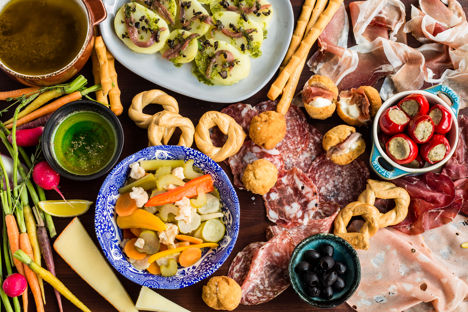
The art of antipasti
Amy Gulick guides us through the history of antipasti, with a few fantastic recipes to inspire you for your next Italian feast.
The art of antipasti
Amy Gulick guides us through the history of antipasti, with a few fantastic recipes to inspire you for your next Italian feast.
Across many of the world’s culinary traditions, starting a meal with small portions of salad, pickled vegetables, cold cuts or various bite-sized savouries has been customary for centuries. Ancient Romans perceived the ‘appetiser’ course as crucial to stimulating the appetite, and thus preceded their at-times notoriously decadent meals with light pastries, or vegetables accompanied by spicy sauces. Pre-meal drinks that today we know as aperitif or aperitivo, also meant to stir the appetite, figured in this eating ritual as well. Cicero himself is said to have called the rite promulsis, from the name of a common Roman drink served at the start of a meal, the honey wine mulsum.
The custom fell out of favour in the Middle Ages, to be revived during the Renaissance when some of Italy’s early ‘celebrity’ chefs, figures such as Bartolomeo Scappi, were elaborating on medieval taste preferences and incorporating modern techniques and ingredients newly-introduced to Europe into contemporary cooking. This era saw the revival of serving platters of what today we might call ‘finger foods’ on a credenza, a sideboard separate from the dining table. This course subsequently evolved into the hors d'oeuvre.
Today the antipasto course remains fundamental to Italian dining, in large part due to beliefs concerning digestion and the importance of prepping the stomach for foods, and temperatures, to come. (Interestingly, the still-observed habit of serving a small salad at the start of a meal derives from this notion.) While Italians tend to serve their salad course at the close of a meal, their antipasto plates invariably feature different preparations of vegetables: crudo (fresh vegetables sliced like crudités), sott’olio (grilled or roasted vegetables packed in olive oil), or sott’aceto (vegetables pickled in vinegar and spices). In addition to vegetables, a traditional antipasto platter will include an assortment of salumi, cold cuts such as prosciutto crudo, culatello, and salame, together with olives, crostini or fried polenta squares topped with sauces or pâtés, and devilled eggs.
An antipasto course can vary from an abundant and colourful display brimming with Italian delicacies to a simple plate of a few topped crostini and cured meats. Have a look at a few of our favourites as you plan your next multi-course, authentic Italian meal.
These dollops of deep-fried dough, whose name translates to 'cuddles', could well be the ultimate Tuscan comfort food. Served with soft stracchino cheese and slices of prosciutto crudo, coccoli are usually served as an antipasto in Tuscany, though, being on the heavy side, they easily make for a main course or sharing plate.
These stuffed peppers originate in the southern Italian region of Calabria, where chilli peppers and spicy pepper products like ‘nduja figure greatly in local cuisine. To make them, Italians typically use a pepper variety that goes by the commercial name papecchia – small, round peppers that are very red when ripe and have a thick, medium-hot flesh – yet any type of cherry pepper will work as long as they are round and semi-flat in shape.
Hailing from Tuscany and Piedmont respectively, these two traditional, delightfully easy dipping sauces served with raw or cooked vegetables are popular antipasto dishes.
Pinzimonio, from the Italian verb pinzare (‘to pinch’, yet in this context referring to a biting or spicy quality) is a simple blend of best quality extra virgin olive oil and spices. It is served in small, individual dipping saucers or bowls (one for each guest) at the beginning of a meal.
The savoury Piedmontese sauce bagna cauda (‘warm sauce’) owes its punchy quality to garlic and anchovy, relying on small portions of ‘poor’ yet pungent ingredients to flavour a large batch of sauce. To keep the sauce warm, Italians serve bagna cauda in a terra cotta warming stove fitted with an underside opening to hold a votive candle. This sauce is presented communally, for all to share around the table, accompanied by steamed or roasted root vegetables.
This classic antipasto dish is comprised of a variety of seasonal pickled vegetables, flavoured with herbs and spices like bay leaves, rosemary, peppercorns, or garlic cloves. Serve the vegetables on a large antipasto platter together with cold cuts, olives, and cheeses with toothpicks set out for guests to use for tasting.
Italian cooks, whether master chefs or self-taught at home, frequently rely on flavour-packed anchovies and capers to boost savoury potential in everything from pasta sauces and pizza to grilled fish and meats. Here, the two essential Italian ingredients combine with a lemon-herb sauce to render these potato ‘discs’ wonderfully salty and tangy.


